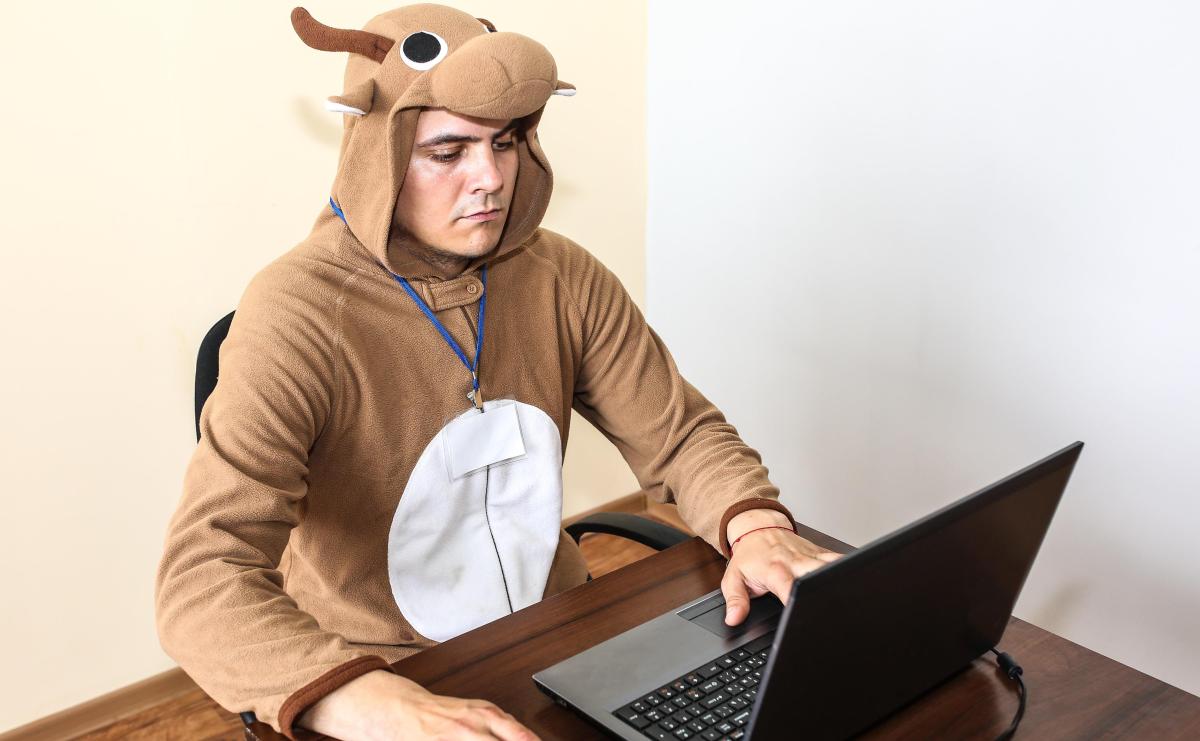If you’re used to working from an office, working from home in this shutdown might be a brutal adjustment. But it’s also a golden opportunity to acknowledge different temperaments and working styles. So here are some ‘anti-tips’ to counter the more prescriptive advice that’s been floating about.
1. Find your own working from home wardrobe
You might have seen advice to ‘stick to your usual routine’ by showering and dressing in the morning – even including shoes! But as freelancers know, you can work perfectly well in pyjamas, underwear or ancient tracksuit pants. Work clothes are purely about cooperating with the social norms of a shared physical space. If you’ll be using videoconferencing to meet with coworkers, follow the time-honoured habits of newsreaders and focus your grooming on your upper body.
Banyans are loose silk robes inspired by traditional Asian dress, which became popular in the West as casual, at-home wear – it was particularly stylish for 17th– and 18th-century intellectuals to wear them in portraits. Channel your inner Hugh Hefner in a smoking jacket – they’re basically, short dressing gowns made of unstructured, soft fabrics. Get into cardigans – remember that the first thing Mr Rogers did when he got home was swap his suit jacket for a cosy knit.
And there’s a reason why sack dresses are so popular nowadays – they’re the modern version of the loose, easy-to-wear wrappers, morning gowns, tea gowns and housedresses that women wore at home during the 19th and 20th centuries. Victorian ladies even had fancy morning gowns in which they received daytime visitors. That’s like you and your ‘good tracky-dacks’.
2. Pick one regular signal that you’ve clocked on and off
When you aren’t getting ‘presence cues’ from coworkers in a shared physical space, it can be hard to pace your workday – and it’s easy to give in to paranoid feelings that you need to be super-present on email, group chat and videoconferencing to ‘perform’ the fact you’re working.
Use a designated platform for all coworkers to check in and out every day. And for yourself, decide on a mental cue that mimics the moment of putting down your jacket and bag at your desk, and picking them up to go home. Perhaps you can put on a particular garment when you start work, and leave it on your desk chair when you’re done. I have a ‘work cardigan’.
3. You don’t need to be a perfect, prompt communicator
For every gregarious person who thrives on video or online chat, there’s someone who finds it distracting and overwhelming. Some people prefer the lower stimulation of email and phone calls. And just as in the office, some people are always ‘available’ for a chat, while others prefer to ‘close their door’ or ‘put their headphones on’ to get work done.
Read: 18 rules for freelancing from home (from the archives)
If you’re feeling stressed by switching between digital channels, go easy on yourself. Human brains aren’t good at dividing attention – plenty of studies show that multitasking is a fantasy. Try checking notifications at set times or turning off real-time pings. Or shift your peak work time to early morning or late evening, when others are offline.
4. Identify your anxiety response and your coping style
We’re all freaking out right now, but people respond to anxiety in different ways: fight, flight, or freeze. These can change by the day, or by the hour. So try to figure out which one you’re doing, and how to align your working habits with your instinctive coping style.
For instance, an extroverted activity addict might choose a fight response: elaborate to-do lists, starting up industry advocacy groups, or learning new skills. And they might feel frustrated if others aren’t following their lead. Meanwhile, someone in flight mode might avoid communicating and feel attacked by efforts to get in touch. But they might relish independent work.
5. Faffing about is okay
A lot of office time is not strictly devoted to working. You’ll head in and out for meetings and appointments, or have conversations with coworkers. You’ll spend time organising your workspace, or get distracted by emails or social media. Away from the office, it’s easy to feel you’ve got to put in the same hours, or even longer, to compensate for your lack of presence. If you find you’re getting your work done in half the time, don’t feel guilty. Well done, you nailed it!
But don’t beat yourself up for being lazy when faffing is only human, and the full-time workday is a capitalist construct. If you’re really struggling to concentrate, this could be your body saying it’s time for a snack, some fresh air, or some water.
6. Don’t force creativity just because this looks like downtime
As arts workers we’re used to putting our own creative work on the backburner. So it’s easy for us to feel like we ought to be devoting time at home to a new or neglected creative project. How many memes have you seen recently about some famous creative who used a period of self-isolation to do important work?
If starting a new project will help you cope (see point 4), then go for it. But don’t push yourself if you’re feeling wrung out. Neoliberalism wants us to always be grinding – to be productive, enterprising workers who adapt flexibly to even the most catastrophic circumstances. Reject that. Rest and stillness can be creatively fertile, too.

